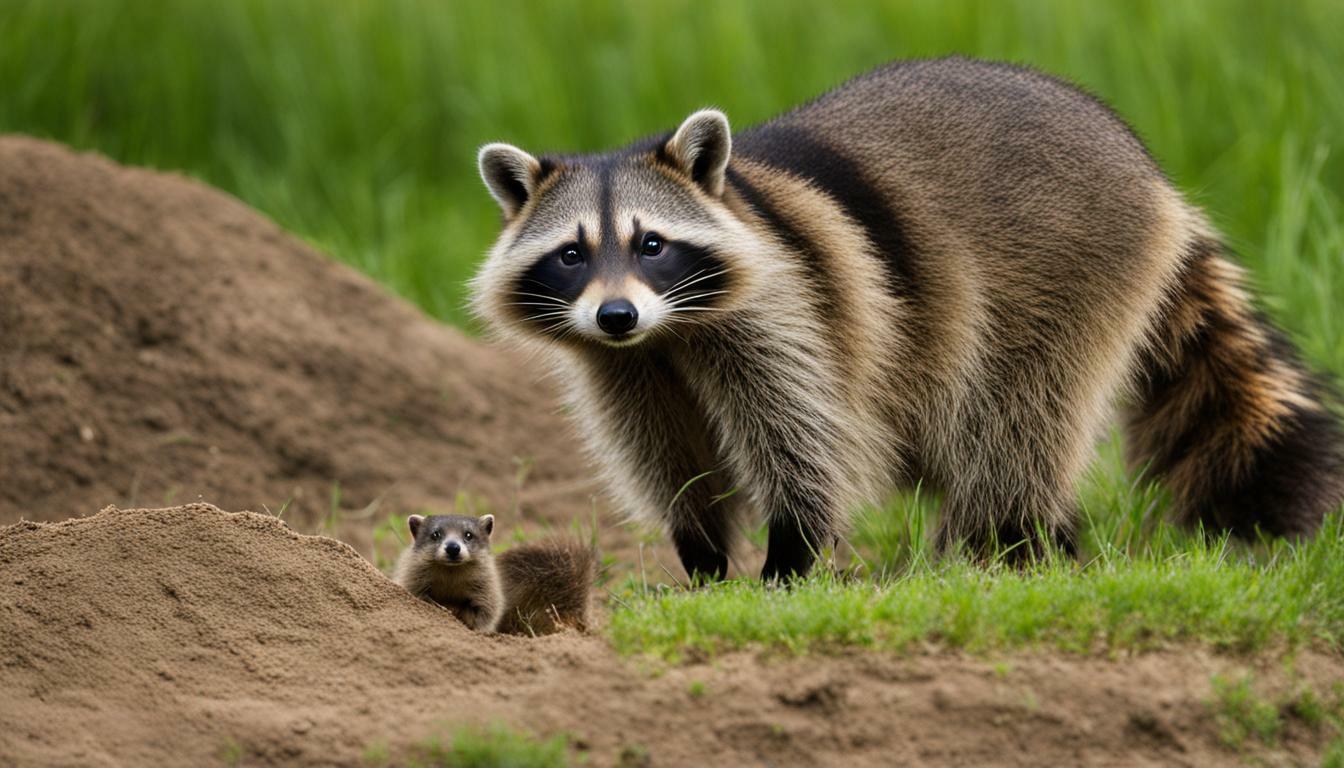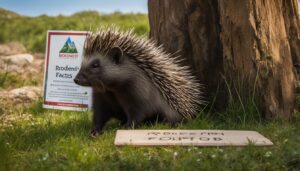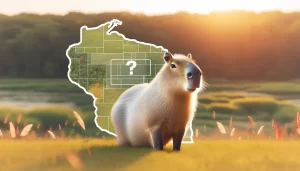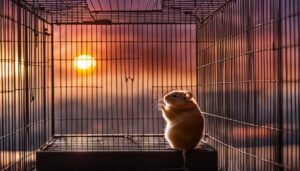Have you ever wondered if raccoons and groundhogs can coexist peacefully in the wild?
Raccoons and groundhogs do not get along and are unlikely to encounter each other. Raccoons are opportunistic feeders, eating a variety of plant and animal matter. However, they generally do not eat groundhogs. Groundhogs are larger than the small animals that raccoons typically eat, and hunting and catching them would require too much energy for raccoons. Groundhogs mainly eat plants and insects and are preyed upon by animals such as domestic dogs, foxes, coyotes, and humans. Groundhog burrows also provide homes for other wildlife species like skunks and raccoons. Overall, raccoons and groundhogs have different behaviors and lifestyles, causing them to not get along.
Key Takeaways:
- Raccoons and groundhogs do not get along due to their different behaviors and lifestyles.
- Raccoons are opportunistic feeders and generally do not eat groundhogs.
- Groundhogs mainly eat plants and insects and are preyed upon by other animals, including humans.
- Groundhog burrows provide homes for other wildlife species such as skunks and raccoons.
- Coexistence between raccoons and groundhogs in the wild is unlikely.
Understanding Raccoons and Groundhogs
To understand whether raccoons and groundhogs get along, it’s essential to explore their individual characteristics and behaviors. Raccoons, known for their mischievous nature, are opportunistic feeders that have a diverse diet consisting of plants, small animals, and even garbage. However, raccoons typically do not prey on groundhogs.
Groundhogs, on the other hand, are larger than the typical prey of raccoons. These herbivores mainly feed on plants and insects, making them an unlikely target for raccoons. Hunting and capturing a groundhog would require a significant amount of energy, which raccoons are unlikely to expend.
Furthermore, groundhogs serve as prey for various animals, including domestic dogs, foxes, coyotes, and even humans. Their burrows also provide homes for other wildlife species such as skunks and raccoons. While raccoons and groundhogs may share habitats due to their burrowing behaviors, their different behaviors and lifestyles prevent them from getting along.
| Raccoons | Groundhogs |
|---|---|
| Raccoons are opportunistic feeders that eat a variety of plant and animal matter. | Groundhogs are herbivores that primarily feed on plants and insects. |
| Raccoons do not typically prey on groundhogs due to their larger size. | Groundhogs are unlikely to be hunted by raccoons as they require too much energy to capture. |
| Raccoons are more adaptable to urban environments, often causing conflicts with other wildlife species. | Groundhogs prefer burrowing habitats and are vulnerable to predation by various animals. |
Raccoon Behavior and Diet
Raccoons are known for their adaptability and opportunistic feeding behavior, which can lead to interactions with various wildlife species in urban settings. These intelligent creatures have a diverse diet that includes fruits, nuts, small mammals, birds, eggs, insects, and even garbage. However, when it comes to groundhogs, raccoons are unlikely to view them as prey or engage in any significant interactions.
Raccoon Diet
Raccoons are omnivorous, meaning they consume both plant and animal matter. Their diet varies depending on the season and availability of food. In urban areas, raccoons often scavenge for human food waste, raiding trash cans and dumpsters. They are also skilled hunters and can catch small prey such as mice, rats, and rabbits. While raccoons possess the capability to kill larger animals, groundhogs are not typically part of their diet due to several reasons.
| Raccoon Diet | Groundhog |
|---|---|
| Small mammals such as mice and rats | Herbivorous |
| Eggs and birds | Not a typical prey |
| Small fish and amphibians | Preyed upon by larger animals |
| Fruits, nuts, and vegetables | Prefer plant-based diet |
Groundhogs, also known as woodchucks, have a predominantly herbivorous diet consisting of grasses, leaves, and other plant matter. They are not small enough to be considered prey for raccoons, and hunting and catching a groundhog would require a significant amount of energy. Raccoons typically prefer smaller, easier-to-catch prey, making groundhogs an unlikely target.
In conclusion, raccoons and groundhogs do not get along due to their differing behaviors and lifestyles. While raccoons are adaptable and opportunistic feeders, their diet consists of smaller prey and a combination of plant and animal matter. Groundhogs, on the other hand, mainly eat plant material and are more vulnerable to larger predators. Although raccoons and groundhogs may share habitats, their interactions are minimal, and they tend to coexist without significant conflict.
Groundhog Behavior and Diet
Groundhogs, also known as woodchucks, have distinct behaviors and dietary preferences that contribute to their interactions with other wildlife species. These small mammals are primarily herbivores, feeding on various types of plants, including grasses, clovers, and dandelions. Their diet also includes fruits, vegetables, and tree bark. Groundhogs are known for their burrowing behavior, creating intricate underground tunnel systems that serve as their homes and provide protection from predators.
Groundhogs play a vital role in ecosystems as their burrows often become habitat for other wildlife species. Skunks, raccoons, and even snakes are known to take up residence in abandoned groundhog burrows. This shared habitat can lead to indirect interactions between groundhogs and these other wildlife species. However, direct interactions between groundhogs and raccoons are rare.
Raccoons, on the other hand, are opportunistic feeders and have a more diverse diet, consisting of both plant and animal matter. While they are known to raid garbage bins and seek out easily accessible food sources, raccoons typically do not prey on groundhogs. The size difference between the two animals, with groundhogs being larger than the typical prey of raccoons, makes hunting and catching them impractical for raccoons. Their differing dietary preferences and behaviors contribute to the limited interactions between raccoons and groundhogs.
| Groundhog Behavior and Diet | Raccoon Behavior and Diet |
|---|---|
| – Herbivores | – Opportunistic feeders |
| – Feed on plants, fruits, and tree bark | – Feed on plants, animals, and garbage |
| – Burrow and create underground homes | – Adapt to various habitats, including urban environments |
| – Provide habitat for other wildlife species | – Compete with other wildlife for resources |
In conclusion, raccoons and groundhogs have different behaviors and dietary preferences that contribute to their limited interactions. While groundhogs mainly feed on plants and create burrows that become habitat for other species, raccoons are more adaptable and have a broader diet. Their divergent lifestyles and the size difference between the two animals make it unlikely for raccoons and groundhogs to have significant direct interactions. However, their shared habitat and the presence of other wildlife species in groundhog burrows can indirectly connect them within the ecosystem.
Differences in Size and Diet
The significant disparities in size and diet composition between raccoons and groundhogs contribute to their unique ecological roles and minimal interactions in the wild. Raccoons, typically weighing between 10-30 pounds, are opportunistic feeders that consume a wide range of plant and animal matter. Their diet consists of fruits, nuts, insects, small mammals, birds, eggs, and even human garbage.
On the other hand, groundhogs are much larger, weighing around 12-15 pounds. They are herbivores, primarily feeding on a variety of plants such as grasses, clover, dandelions, and vegetables. Insects also make up a small portion of their diet, but animal matter is generally not a significant part of their food sources.
Due to their differing dietary preferences and size discrepancies, raccoons and groundhogs rarely compete for the same resources. Raccoons typically seek smaller prey or easily accessible plant matter, while groundhogs focus on consuming vegetation found in their burrow habitats. These distinct adaptations result in minimal overlap in their food sources and limited opportunities for direct encounters or conflicts between the two species.
| Raccoons | Groundhogs |
|---|---|
| Weight: 10-30 pounds | Weight: 12-15 pounds |
| Diet: Fruits, nuts, insects, small mammals, birds, eggs, human garbage | Diet: Grasses, clover, dandelions, vegetables, insects |
| Adaptations: Opportunistic feeding habits, adaptability to urban environments | Adaptations: Herbivore, burrower |
Predators and Prey
Both raccoons and groundhogs have predators and prey that influence their interactions and behaviors in the wild. Raccoons are opportunistic feeders and have a varied diet that includes small animals, fruits, and vegetables. However, groundhogs, being larger in size, are not typically on the menu for raccoons. Hunting and catching a groundhog would require a significant amount of energy for a raccoon, making it an unlikely target. Groundhogs primarily feed on plants and insects, and they are often preyed upon by larger predators such as domestic dogs, foxes, coyotes, and even humans.
Groundhog burrows, which can be extensive and complex, also serve as homes for other wildlife species. It is not uncommon to find raccoons and skunks sharing the same burrow system constructed by groundhogs. This cohabitation can lead to indirect interactions between raccoons and groundhogs, as they navigate the shared habitat and adapt to the presence of one another.
In conclusion, while raccoons and groundhogs may occupy the same general area and even share burrows, their interactions are minimal due to their different behaviors, diets, and sizes. Raccoons are more likely to prey on smaller animals and scavenge for food, while groundhogs are herbivores that prefer plant matter. Their distinct lifestyles and ecological roles reduce the likelihood of them getting along in the wild. However, their shared habitat provides opportunities for subtle interactions and adaptations as both species navigate their surroundings.
| Raccoons | Groundhogs |
|---|---|
| Opportunistic feeders | Herbivores |
| Preyed upon by larger predators such as domestic dogs, foxes, coyotes, and humans | Preyed upon by larger predators such as domestic dogs, foxes, coyotes, and humans |
| Can share groundhog burrows with other wildlife species like skunks | Construct extensive burrow systems that can house other animals like raccoons and skunks |
Shared Habitat and Burrows
Raccoons and groundhogs often share habitats and even utilize the same burrows, leading to potential coexistence and adaptations in their respective behaviors. In urban areas, where both species are commonly found, their overlapping territories can result in indirect interactions as they navigate the same environment.
While raccoons are agile climbers and can easily access trees and rooftops, groundhogs prefer to dig burrows underground. These burrows serve as homes and provide protection from predators for both groundhogs and other wildlife species, including raccoons. The groundhog burrows often have multiple entrances and chambers, creating opportunities for animals like raccoons to seek shelter or even use them as temporary resting spots.
Within shared habitats, raccoons and groundhogs may also affect each other’s behavior. For example, raccoons may learn from groundhogs’ cautious nature and adjust their own behavior accordingly, becoming more wary of potential threats. This adaptation allows them to coexist in the same environment without direct conflicts.
Shared Habitat and Burrows Table:
| Raccoons | Groundhogs |
|---|---|
| Opportunistic feeders | Herbivores |
| Adaptable to urban environments | Prefer open grassy areas near woodlands |
| Can climb trees and access rooftops | Create burrows for shelter |
In summary, while raccoons and groundhogs have different behaviors and diets, they often coexist in the same habitats and even utilize the same burrows. Their interactions may be indirect, with each species adapting to the presence of the other. This coexistence highlights the resilience and adaptability of urban wildlife, and underscores the importance of understanding and respecting the diverse range of species that share our environments.
Observations of Raccoon-Groundhog Interactions
While raccoon-groundhog interactions are relatively uncommon, there have been occasional observations and research studies that provide insights into their relationship. These observations suggest that raccoons and groundhogs typically do not get along and tend to avoid each other. This is likely due to their different behaviors and lifestyles.
Occasional Interactions
In rare instances where raccoons and groundhogs have been observed together, it is often in shared habitats such as suburban areas or parks. However, even in these cases, the interactions are often limited to passive coexistence, with each species going about their own activities without direct interaction or conflict.
Studies have shown that raccoons are primarily interested in scavenging for food and exploring their surroundings, while groundhogs focus on grazing and maintaining their burrows. As a result, their paths rarely cross, reducing the likelihood of any significant interactions.
Different Behaviors and Lifestyles
Raccoons are known for their opportunistic feeding habits, consuming a wide range of plant and animal matter. However, they generally do not prey on groundhogs. The size difference between the two animals plays a role, as groundhogs are larger than the typical prey of raccoons.
| Raccoons | Groundhogs |
|---|---|
| Raccoons are opportunistic feeders | Groundhogs are herbivores |
| They eat a variety of plant and animal matter | Mainly eat plants and insects |
| They adapt well to urban environments | Preyed upon by animals such as dogs, foxes, coyotes, and humans |
| Their diet rarely includes groundhogs | Groundhog burrows can provide homes for other wildlife |
Additionally, groundhogs face predation from various animals, including domestic dogs, foxes, coyotes, and humans. Raccoons, on the other hand, are known to take advantage of groundhog burrows for shelter or denning, but this is more of an indirect interaction rather than a direct relationship between the two species.
Overall, the combination of different behaviors, diets, and habitats make raccoons and groundhogs unlikely to get along. While they may occasionally coexist in the same areas, their interactions are minimal, with each species focusing on their own survival and adaptation strategies.
Wildlife Conflict Resolution
Wildlife conflict resolution plays an important role in managing interactions between raccoons, groundhogs, and other wildlife species, ensuring a harmonious coexistence. When conflicts arise, it is crucial to address them in a way that minimizes harm to both animals and humans.
One effective method of wildlife conflict resolution is implementing deterrent measures to prevent encounters between raccoons, groundhogs, and humans. This can include securing garbage cans with tight-fitting lids to discourage raccoons from scavenging, as well as installing barriers or fences to prevent groundhogs from entering gardens or damaging crops.
Another approach is habitat modification, which involves altering the environment to make it less appealing or accessible to raccoons and groundhogs. For example, removing potential food sources, such as fallen fruits or nuts, can discourage raccoons from frequenting certain areas. Additionally, filling in groundhog burrows or installing underground barriers can help prevent groundhogs from establishing dens near residential areas.
Table: Strategies for Wildlife Conflict Resolution
| Strategy | Description |
|---|---|
| Deterrent Measures | Securing garbage cans and installing barriers or fences to discourage wildlife from entering human spaces. |
| Habitat Modification | Altering the environment to make it less appealing or accessible to wildlife, such as removing potential food sources or filling in burrows. |
| Exclusion Techniques | Using physical barriers like netting or electric fences to exclude wildlife from specific areas. |
| Humane Trapping and Relocation | Capturing wildlife and relocating them to suitable habitats away from human-populated areas, ensuring their survival. |
| Educational Outreach | Providing information and resources to the community about coexisting with wildlife and implementing effective wildlife management practices. |
In cases where other strategies are ineffective or not feasible, humane trapping and relocation may be considered as a last resort. This method involves capturing raccoons or groundhogs and releasing them in suitable habitats away from human-populated areas. It is important to ensure that such relocation adheres to local regulations and guidelines to ensure the survival and well-being of the animals.
Furthermore, educational outreach plays a vital role in promoting harmonious coexistence between humans and wildlife. By providing information about the behavior, habits, and needs of raccoons, groundhogs, and other wildlife species, individuals can make informed decisions and take proactive measures to minimize conflicts. This may include disseminating materials, organizing workshops, or partnering with local wildlife organizations to raise awareness and encourage responsible wildlife management practices.
Urban Wildlife and Coexistence
As urban areas continue to expand, it becomes crucial to find ways to coexist with raccoons, groundhogs, and other wildlife species in our neighborhoods. Urban wildlife encounters can be both fascinating and challenging, but with the right knowledge and practices, we can ensure a harmonious relationship with these animals.
Raccoons and groundhogs are no exception when it comes to wildlife that adapt to urban environments. They have learned to thrive alongside humans, taking advantage of the food and shelter opportunities provided by our urban landscapes. However, conflicts can arise when their behaviors and needs overlap with ours.
To minimize conflicts and promote coexistence, it’s important to understand the behaviors and needs of raccoons and groundhogs. By making our neighborhoods less enticing to these animals, we can encourage them to seek out more natural habitats. This can be achieved by securing garbage cans, removing potential food sources from yards, and sealing off access to crawl spaces and attics.
Education and community involvement also play a vital role in wildlife conflict resolution. Local authorities and wildlife organizations can provide resources and guidelines on what to do if you encounter raccoons or groundhogs in your neighborhood. By working together, we can create a safer and more harmonious environment for both humans and urban wildlife.
| Do’s | Don’ts |
|---|---|
|
|
By implementing these practices and fostering a culture of respect and understanding towards urban wildlife, we can create a thriving coexistence between humans and animals like raccoons and groundhogs. As we continue to build and expand our urban areas, it’s essential to prioritize the preservation of biodiversity and the integration of nature into our everyday lives.
Human-Wildlife Interactions
Human actions and attitudes can significantly impact the dynamics of raccoon-groundhog interactions and influence the overall well-being of wildlife populations. When it comes to urban wildlife, such as raccoons and groundhogs, coexistence and responsible behavior are key. By understanding the behaviors and needs of these animals, we can better manage wildlife conflicts and promote harmonious interactions.
One important aspect of human-wildlife interactions is the provision of suitable habitat. Urban areas often lack natural habitats for raccoons and groundhogs, leading them to seek shelter in residential areas. By securing garbage cans, sealing off potential entry points to buildings, and eliminating food sources, we can reduce the likelihood of raccoons and groundhogs entering our properties and causing conflicts.
Additionally, educating the public about the importance of wildlife conservation and the potential risks associated with improper wildlife management is crucial. Encouraging responsible behavior, such as not feeding wildlife and avoiding intentional or unintentional harm to these animals, can help foster positive interactions. Implementing wildlife conflict resolution strategies, such as using exclusion methods to deter animals from unwanted areas or seeking professional wildlife removal services when necessary, can also contribute to peaceful coexistence.
Table: Tips for Coexistence with Raccoons and Groundhogs
| Tips | Explanation |
|---|---|
| Secure garbage cans | Raccoons are known for their scavenging behavior, and securing garbage cans can prevent them from accessing food sources. |
| Seal off entry points | By sealing up any potential entry points to buildings or structures, we can reduce the chances of raccoons and groundhogs seeking shelter indoors. |
| Eliminate food sources | Removing food sources, such as bird feeders or pet food left outside, can discourage wildlife from frequenting residential areas. |
| Avoid intentional or unintentional harm | Respecting wildlife and avoiding actions that may harm or disturb them, such as trapping or poisoning, is essential for coexistence. |
| Seek professional wildlife removal services | If conflicts persist or become unmanageable, it is advisable to seek the assistance of trained professionals who can safely remove animals from the area. |
By adopting these practices and promoting responsible behavior, we can create an environment where raccoons, groundhogs, and other wildlife can thrive alongside human communities. Remember, wildlife interactions can be fascinating and enriching, but it is our responsibility to ensure the well-being of both animals and humans.
Conclusion
In conclusion, while raccoons and groundhogs have different behaviors and lifestyles, they generally do not get along due to their distinct dietary preferences and size differences. Raccoons are opportunistic feeders, consuming a variety of plant and animal matter. However, groundhogs, being larger than the usual prey of raccoons, are not typically included in their diet. Hunting and catching groundhogs would require too much energy for raccoons, making it an unlikely occurrence.
On the other hand, groundhogs primarily eat plants and insects, making them herbivores. Due to their dietary preferences, they are preyed upon by larger animals such as domestic dogs, foxes, coyotes, and even humans. Interestingly, groundhog burrows also provide homes for other wildlife species like skunks and raccoons, but this doesn’t imply a harmonious relationship between the two.
It’s important to note that raccoons and groundhogs have distinct behaviors and lifestyles. Raccoons are adaptable to urban environments and are known for their scavenging abilities, which can lead to potential conflicts with other wildlife. Groundhogs, on the other hand, are burrowers and prefer habitats conducive to their burrowing needs. Although they may occasionally share habitats or utilize shared resources, direct interactions between raccoons and groundhogs are rare.
To ensure wildlife coexistence, it is crucial to practice responsible behavior and proper wildlife management. By understanding the behaviors and needs of different wildlife species, humans can better navigate their interactions with raccoons, groundhogs, and other animals. Being mindful of our actions and providing appropriate habitats for wildlife can help minimize conflicts and promote harmony between humans and wild animals.
FAQ
Do raccoons and groundhogs get along?
No, raccoons and groundhogs do not get along. They have different behaviors and lifestyles that make it unlikely for them to interact with each other.
What do raccoons eat?
Raccoons are opportunistic feeders and eat a variety of plant and animal matter. However, they generally do not eat groundhogs.
What do groundhogs eat?
Groundhogs mainly eat plants and insects.
Are raccoons and groundhogs preyed upon by the same animals?
No, raccoons and groundhogs have different predators. Groundhogs are preyed upon by animals such as domestic dogs, foxes, coyotes, and humans.
Do raccoons and groundhogs live in the same burrows?
Groundhog burrows can provide homes for other wildlife species like skunks and raccoons, but raccoons and groundhogs do not typically share the same burrow.
Are there any documented raccoon-groundhog interactions?
While rare, there have been observations and studies on raccoon-groundhog interactions, providing insights into potential behaviors exhibited during those encounters.
How can wildlife conflicts involving raccoons and groundhogs be resolved?
Wildlife conflict resolution strategies can be employed to mitigate any issues that arise from raccoon-groundhog interactions.
What are the challenges associated with urban wildlife?
Urban wildlife, including raccoons and groundhogs, present challenges and opportunities for coexistence. Understanding their behavior and implementing responsible wildlife management practices are key.
How should humans interact with raccoons and groundhogs?
Humans should practice responsible behavior and proper wildlife management to ensure peaceful interactions with raccoons, groundhogs, and other wildlife species.




